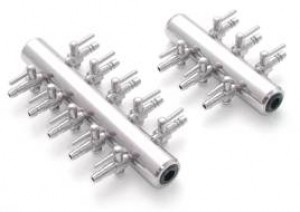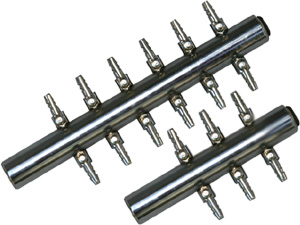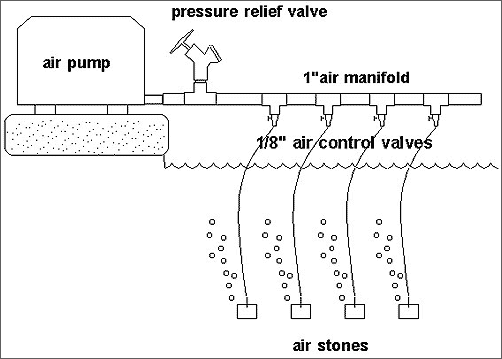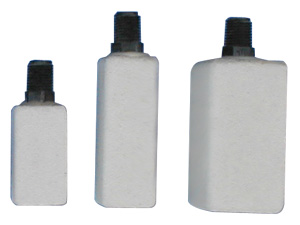 We recommend that you use these small manifolds for aquariums. These small air manifolds can exert too much back pressure on your pump if used incorrectly. You may use these small air manifolds to split your air to ceramic type air stones for aquarium applications or in cases where you need to put air stones in various locations around the pond or filter. It allows you to vent off potential back pressure if you are not using all outlets. Use all available air outlets on the manifold. Do not restrict the air pumps ability to breathe and cool itself. See section on Troubleshooting.
Use the 6 way manifold only for HK 25L.
Use the 12 way manifold for HK 40L to HK 60L.
Use two (2) 12 way manifolds for the HK80L.
Use three (3) or four (4) 12 way manifolds with HK 100L or 120L.
Connect the outlet of your air pump to a 6 or 12 way manifold. In case you are using multiple manifolds for the larger pumps, use 5/8" to 1" pipe or hose to connect multiple manifolds.
The manifold has 3/16" valves which control the outlet of air to your air stones or diffusers.
- 3/16" Valved Taps
- Available with 6 or 12 Taps
- Use 3/16" air hose for distances less than 3 feet and 1/4" air hose up to 5 feet.
E-mail us for help with your assembly. info@HakkoAirPumps.com
THE AIR MANIFOLD
 The air manifold is very important for two reasons. It gives us the ability to send air to various areas within the aquarium and allows us to vent off potential back pressure. The air manifold is very important for two reasons. It gives us the ability to send air to various areas within the aquarium and allows us to vent off potential back pressure.
Connect the outlet of your HAKKO to a 6 way or 12 way brassl manifold which is available separately. The manifold has valves which control the outlet of air to your air stones or diffusers. Alternatively, you may make a manifold with PVC parts and small ball cock valves ( available separately).

RELIEVING BACK PRESSURE
It may be important for the longevity of your HAKKO performance that you install a “BLEEDER VALVE”. The optional bleeder valve can be a secondary valve which is “cracked” open just enough to vent off excess back pressure. You may also use one of the existing outlets on the stainless steel manifold. Simply do not use one or two of the outlet valves and leave them open to bleed off excess back pressure. The 2 way Heavy Duty Manifold in the picture can be used as a air bleeder to ventilate off excess unwanted air from a Hakko Air Pump.
TUBING AND PIPE
Always use large diameter pipe or plastic tubing to connect your manifolds and air diffusers.
Use “non kink” hose so it does not ultimately restrict air delivery to the pond. Self sinking weighted tubing is available. Use ½ inch diameter pipe as a minimum to connect to your air manifold. The air manifold should also be large diameter to reduce back pressure. Use heavy duty ¼” diameter airline tubing to your air stones. Do not use the small aquarium style airline tubing to connect your air stones. This tubing is too small diameter and kinks very easily. Contact one of your HAKKO Distributors link for the correct size tubing to maximize the performance of your air pump.
AIR STONES AND DIFFUSERS
 The best air stone on the market is the ceramic stone type. They come in a variety of sizes and have a very long life. Choose the air stone size and quantity which will match the air output of your HAKKO. The best air stone on the market is the ceramic stone type. They come in a variety of sizes and have a very long life. Choose the air stone size and quantity which will match the air output of your HAKKO.
Most air stones are rated to deliver or allow a certain amount of air per minute. Usually they are rated in cubic feet of air per minute or cfm.
A small air stone may only allow 0.05 cubic feet air per minute. A large size air stone might allow 0.5 cfm. If you use too small an air stone or too few, you will place excess back pressure on the air pump. You can increase the number or size of stones or use a pressure relief valve.
To convert your air pumps rating of Liters per Minute to Cubic Feet per Minute divide lpm by 28.25 to give cfm. Example: your HAKKO 40L will deliver over 50 lpm at 58 inches water depth. 50 ÷ 28.25 = 1.77 cfm. A 1.5” x 1.5” ceramic air stone will allow 0.25 cfm, you should use at least 7 of this size air stone.
Air stones will make a medium small bubble size. You can find air stones which make a very fine bubble however, these will not obtain a good speed in rising to the surface and will put a lot of back pressure on the air pump. The amount of oxygen that is diffused into the surrounding water from the bubble is small compared to the surge of upwelling water creating surface turbulence. A medium small air bubble will lift considerable water volumes to the surface for aeration and give better overall performance.
CLEANING THE AIR STONES
Air stones need periodic cleaning due to calcium and carbonate buildup from the water. Some areas around the country have hard water with a high calcium level. This calcium can eventually plug up your air stone and create unwanted back pressure on the air pump.
Ceramic style air stones can be cleaned in 100% muriatic acid for an hour to clear the calcium and return the air stone to like new performance. Clean your air stones 3 to 4 times per year in hard water areas and 2 times per year in soft water areas. This will keep your warranty valid. | 
